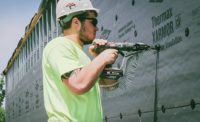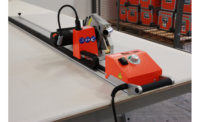Drywall finishing a four-story, 400,000-square-foot office building is a tall order under any circumstance. Multiply that by two and add in a compressed construction schedule, and you can better appreciate the challenge recently faced by Rob LeRoy.
LeRoy, a 20-year finishing veteran with Wisconsin-based construction service provider Wall-tech Inc., was hired to drywall finish two office buildings owned by Epic, a worldwide software manufacturer based in Verona, Wis.
“With 8,333 sheets quoted per building, we knew we had to maximize every hour of worker productivity to win this job and stay profitable,” recalls LeRoy. “It’s an especially difficult task in today’s construction industry, where a shortage of manpower has made completing such large jobs in a timely manner quite an exercise.”
Fortunately, resourceful construction practices, coupled with a productivity-saving drywall finishing pump, ended up saving Wall-tech $84,000 in labor costs and 1,400 man-hours on the three-month project.
Running a Smooth Operation
With 3,000 hours allotted for a level four finish at each individual Epic building—or roughly 50 hours a day among the five-man crew—LeRoy was under pressure to maximize efficiencies wherever possible.
LeRoy sought to increase job site efficiency by starting crews after the majority of mechanicals was installed.
“Trades can do a much better job and make more money if they work consecutively as much as possible, and not work on top of each other,” asserts LeRoy, who acknowledges that overlapping job site schedules is a fact-of-life and often cannot be avoided. “It’s a classic case of ‘too many cooks spoiling the broth,’ where the constant back and forth between different trades cuts into productivity.”
At the same time, LeRoy, who previously worked at a modular home factory, employed another time-saving sequential building strategy—hanging drywall vertically instead of horizontally. Many contractors believe that cross-laying the sheets horizontally over studs leads to a stronger wall unit, admits LeRoy.
“The steel bracing used in buildings today means that the walls will be strong whether sheets are hung vertically or horizontally,” explains LeRoy. “The advantage with hanging sheets vertically is that one guy can finish the vertical sheet instead of the conventional system of one taper working on the lower joints and another on the upper.”
The other advantage involves finish quality. “When finishing a horizontal sheet, you have to walk a finishing tool down the wall on stilts for sometimes 30-feet. If you happen to step on a stray screw lying on the ground, you’re going for a ride, not to mention you will have to take another crack at finishing that same seam.”
The Power of Technology
Efficient construction practices can only increase job site productivity to a certain extent. To effectively meet, and even exceed, the tight construction schedule on the Epic project, LeRoy turned to technology.
He first heard about a continuous automatic taping system while browsing the Internet.
“I saw a video that said stopping and reloading tools accounts for roughly 30 percent of a finisher’s day, and I thought this might give us an edge over our competitors,” says LeRoy.
Designed to improve the speed, quality and efficiency of the professional finishing contractor, the Continuous Flow System from AMES Taping Tools pumps drywall compound directly to an automatic taper without the user having to manually refill.
“I immediately approached my supervisor about investing in it,” says LeRoy. “At $10,000, the system was no small expenditure, but after seeing how much time we could save using it, Wall-tech became convinced of its value and purchased two of the systems, while renting the automatic tapers,” explains LeRoy. “We were the first in the Midwest to adopt the constant finishing technology,” says the former hand finisher, who was already aware of how much time automatic finishing tools can save.
The Epic office project became the ideal proving ground for the automated system. Large-scale commercial projects are where the greatest amount of productivity can be gained—or lost. “Any cookie-cutter project in which you have long, repetitive stretches to finish is an ideal candidate for automatic tools like this,” explains LeRoy.
Using the drywall pumping system, Wall-tech was able to complete both buildings in roughly three months with only five tapers. LeRoy estimates that a similar job without the device would have required around eight or nine tapers and likely more time. “We were able to increase productivity by 50 percent using this system,” says LeRoy.
This throughput allowed the team to finish one entire building in 2,300 hours, a full 700 hours under budget, saving $42,000 in local labor costs. Multiplied across both buildings, the savings added up to be over $84,000, or more than 23 percent, and 1,400 hours.
“The financial savings paid for the initial investment in the technology many times over,” calculates LeRoy. The veteran finisher admits that using the automated system did have a learning curve. “Some areas will always require handwork, but the ‘production’ areas are ideal for the labor-saving technology.”
Shrinking Mountains to Molehills
According to LeRoy, one more component was, and continues to be, crucial in successfully tackling large jobs like this one. “All employees need to feel like they have a stake in the project’s success,” explains LeRoy. To that end, Wall-tech has implemented a program called “Great Game of Business,” an open book concept of management where each employee is empowered to “think like an owner.” The program is fostered by Certified Coach Kevin Walter, who helps employees achieve their potential. “He really helps us think creatively,” says LeRoy. Encouraged through financial incentives and the valuing of their opinions, the employees’ cooperation and dedication to completing each job in an efficient manner increases exponentially.
LeRoy was able to shine in the GGOB program through the EPIC project to such an extent that he recently was promoted to Taping and Painting Superintendent at Wall-tech. “Thinking outside the box and developing new ideas to save time and money, such as with the automated system, allowed me to expand my horizons as a Wall-tech professional,” he says.
The Epic project was clearly a success for LeRoy and Wall-tech, and they expect to finish additional buildings for the company in the future. Utilizing savvy business and construction practices, in concert with productivity-saving technology, brought the job’s intimidating demands down to size.








Report Abusive Comment